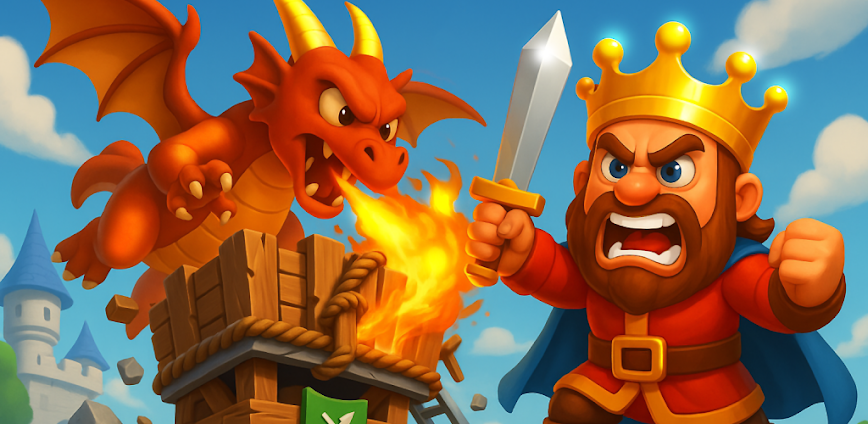Forge of Empires Mod Apk v.1.321.18 (Latest)
- App Name Forge of Empires
- Version 1.321.18
- Sizes 200 MB
- Requirements Android 9
- Developer InnoGames GmbH
- Genre Strategy
- Updated Nov 06, 2025
- Platform GooglePlay
- 1 Establishing Your Empire's Foundation: Strategic City Planning and Resource Management
- 2 The Epochal Journey: Navigating Historical Eras and Technological Advancement
- 3 Diplomacy, Warfare, and Player Interaction: Shaping Your Empire's Destiny
- 4 Sustained Engagement: Community, Events, and the Enduring Appeal of Empire Building
- 5 Conclusion: Key Insights, Recommendations, and Future Perspectives
In an era where digital entertainment constantly evolves, the allure of crafting civilizations and shaping destinies remains profoundly captivating. Mobile gaming platforms have transformed how we engage with complex simulations, bringing sophisticated strategic experiences right to our fingertips. Among these, games that blend historical progression with intricate city-building mechanics have carved a significant niche, offering players a unique blend of creativity, strategy, and long-term engagement. Forge of Empires: Build a City stands as a prime example of this trend, delivering a compelling journey through human history, from the Stone Age to futuristic epochs, all within the confines of a meticulously designed virtual world. Its enduring popularity stems from its ability to offer both a robust solo campaign of empire management and a dynamic multiplayer experience, making it a cornerstone for enthusiasts of mobile strategy games. This article delves into the various facets that make Forge of Empires not just a game, but a comprehensive historical simulation and a testament to strategic prowess.
Establishing Your Empire’s Foundation: Strategic City Planning and Resource Management
The journey in Forge of Empires commences with a modest plot of land, a blank canvas awaiting the touch of a visionary leader. Players are entrusted with the task of transforming this nascent territory into a sprawling, vibrant metropolis. The initial phase of empire building is crucial, focusing on establishing a stable foundation through the strategic placement of essential structures. This involves more than simply dropping buildings; it’s a careful exercise in urban planning, where every decision impacts the city’s efficiency and growth trajectory. Resource generation lies at the heart of early development. Players must construct residential buildings to house their populace, who in turn generate coins – the primary currency for most constructions and research. Alongside this, supply buildings produce goods vital for manufacturing, trading, and unlocking new technologies. Understanding the intricate balance between population growth, resource production, and citizen happiness is paramount. A discontent populace can lead to reduced productivity, highlighting the need for cultural buildings and decorations to boost morale. As the city expands, so does the demand for space and resources. Players are constantly faced with decisions about optimizing their layout to maximize output within limited territorial boundaries. This foundational aspect of Forge of Empires encapsulates the essence of a classic city-building game, challenging players to think ahead and adapt their strategies as their empire grows.
Effectively managing these initial stages sets the stage for exponential growth, allowing players to unlock more advanced structures and expand their dominion. The strategic choices made here, from the arrangement of roads to the type of initial production facilities, lay the groundwork for a prosperous future, ensuring a steady influx of resources needed for the ambitious endeavors that lie ahead. Expansion of territory is another critical element, requiring players to clear adjacent plots of land, often by expending resources or engaging in strategic encounters. This constant push to grow one’s borders necessitates careful foresight, as each new acquisition offers both opportunities for further construction and increased maintenance demands. Developing a sustainable resource economy is key; without a steady flow of coins and supplies, even the most formidable empire can falter. Expert players often emphasize the importance of balancing military and economic growth from the outset. While a strong economy funds expansion, a robust military is essential for defending against potential threats and securing additional resources through conquest. The integration of these elements ensures that Forge of Empires is not merely a click-and-build simulation, but a deeply strategic experience that rewards meticulous planning and adaptive thinking. For those looking to refine their city-building techniques, understanding these fundamental mechanics is the first step towards mastering the game’s complexities. This careful balance of economic engine and territorial gain is a hallmark of successful empire management, pushing players to constantly re-evaluate and optimize their city’s design. Learn more about effective resource management in mobile resource management games.
The Epochal Journey: Navigating Historical Eras and Technological Advancement
Perhaps the most distinguishing feature that sets Forge of Empires apart in the crowded landscape of city-building games is its dynamic era progression system. Unlike static simulations, this game thrusts players through the annals of human history, transforming their fledgling Stone Age village into a high-tech metropolis of the future. The transition between eras is not merely cosmetic; it represents a fundamental shift in available technologies, architectural styles, military units, and strategic challenges. To advance to a new historical period – from the Bronze Age to the Iron Age, and then through the Medieval, Colonial, Industrial, and Modern Eras, eventually reaching the Space Age and beyond – players must meet specific criteria. This typically involves researching a certain number of technologies on the era’s unique technology tree and constructing key buildings. Each era unlocks a host of new possibilities: more efficient production buildings, stronger military units with distinct combat abilities, and advanced cultural structures that boost citizen happiness and productivity.
The visual evolution is striking. Simple mud huts give way to ornate medieval castles, then to industrial factories, modern skyscrapers, and ultimately sleek, futuristic domes. This visual transformation provides a profound sense of accomplishment, allowing players to witness their empire’s evolution through millennia. The challenge lies in adapting one’s strategy to the demands of each new epoch. Earlier eras might focus on basic resource gathering and territorial expansion, while later eras introduce complex global trade networks, advanced warfare tactics, and intricate supply chains. Players must research new military units and develop combat strategies suitable for the evolving battlefield, moving from spear throwers to tanks, and then to advanced futuristic drones. This continuous cycle of development and adaptation ensures that the gameplay remains fresh and engaging, constantly presenting new puzzles to solve and opportunities for innovation. The era progression system acts as a powerful motivator, driving players to continually optimize their empire, pushing the boundaries of technology and societal structure to unlock the next chapter in their civilization’s story.
Diplomacy, Warfare, and Player Interaction: Shaping Your Empire’s Destiny
Beyond the internal development of one’s empire, Forge of Empires introduces a crucial layer of interaction through its ‘neighborhood’ system, where strategic decisions extend beyond city limits and impact broader geopolitical dynamics. Players are not isolated; they exist within a shared world with other human players, creating opportunities for both cooperation and conflict. This external interaction adds a significant strategic depth, forcing players to consider their relationships with neighbors. Military might plays a substantial role. If a player has cultivated a powerful army, they might choose to invade neighboring territories belonging to other players or AI-controlled sectors. Successful invasions can yield valuable resources, boost rankings, or secure strategic advantages. However, this path comes with risks; attacking a stronger opponent can lead to significant losses, depleting military units and resources, and potentially inviting retaliation. Therefore, assessing the strength of one’s military units – ranging from light units to heavy, ranged, and fast units, each with specific combat advantages and disadvantages – is critical before engaging in any offensive action. The game’s combat system is turn-based and tactical, requiring players to deploy units strategically on a hexagonal grid, utilizing terrain and unit abilities to achieve victory.
Alternatively, players can opt for diplomatic solutions. Negotiation and trade are viable paths to acquire necessary resources without resorting to warfare. Players can exchange goods with neighbors, fostering peaceful relationships that can be mutually beneficial. This dynamic choice between aggression and diplomacy is a hallmark of advanced strategy games. Building a strong network of alliances, often through joining or forming guilds, further enhances this interactive experience. Guilds allow players to pool resources, collaborate on challenges, and support each other in conflicts, adding a significant social dimension to the game. These strategic choices – whether to be a benevolent trading partner or a formidable conqueror – profoundly impact the kingdom’s trajectory. A poorly planned military campaign could cripple an economy, while consistent diplomatic engagement could secure long-term stability and access to rare goods. The constant interplay between internal development and external engagement ensures that the strategic landscape is always evolving, demanding astute leadership and a flexible approach from every empire manager. For further insights into complex player interactions in games, consider exploring guides on mastering player-versus-player combat in mobile strategy games.
Sustained Engagement: Community, Events, and the Enduring Appeal of Empire Building
The allure of Forge of Empires extends far beyond its core mechanics of city-building and historical progression; it lies deeply embedded in its capacity for long-term player engagement and its vibrant community features. This is a game designed for enduring commitment, offering a continuous stream of content and interactions that keep players invested for years. One of the primary drivers of sustained engagement is the ongoing cycle of seasonal events, daily challenges, and special quests. These events often introduce unique buildings, powerful military units, or rare resources, providing compelling reasons for players to log in regularly and participate. The rewards from these events are crucial for accelerating empire development, offering boosts that can significantly impact a player’s progress through eras or their military strength. These dynamic content additions ensure that the game never feels stagnant, even for veteran players who have traversed multiple historical epochs.
Moreover, the social dimension is integral to the Forge of Empires experience. Players are encouraged to interact with each other through guilds, a system that transforms individual empire management into a collaborative effort. Guilds participate in ‘Guild vs. Guild’ (GvG) combat, where collective strategic planning and resource contribution are paramount to conquering and holding territories on a separate world map. This fosters a strong sense of camaraderie and competition, as members work together to achieve common goals, share strategies, and support each other through resource donations or military assistance. The thrill of coordinated attacks, defending guild territories, and ascending the global leaderboards creates a powerful bond among players. Beyond GvG, the ability to visit neighbors’ cities, aid them with various tasks, and engage in trading creates a friendly ecosystem within the ‘neighborhood.’ This combination of competitive and cooperative multiplayer elements elevates Forge of Empires from a solitary simulation to a rich, interactive online world. The persistent nature of these interactions, coupled with the satisfaction of watching one’s empire grow from humble beginnings to a powerful, technologically advanced civilization, contributes significantly to the game’s remarkable longevity. It’s this blend of individual strategic mastery and collective effort that retains a dedicated global player base, constantly pushing the boundaries of what a mobile strategy game can offer.
Conclusion: Key Insights, Recommendations, and Future Perspectives
Forge of Empires: Build a City stands as a monumental achievement in the realm of mobile strategy and city-building games, offering an unparalleled journey through human history coupled with deep strategic gameplay. Its success is rooted in several key insights: the ingenious era progression system that keeps the gameplay dynamic and fresh, the meticulous resource management that demands careful planning, and the compelling blend of diplomatic and military interactions that foster a vibrant player community. The game brilliantly intertwines the satisfaction of urban development with the strategic complexities of empire management, all while providing a visually evolving narrative of civilization’s march through time.
For aspiring empire builders, a few recommendations can significantly enhance the experience. Firstly, prioritize balanced growth: neglecting either your economy or your military can lead to setbacks. A strong resource base fuels expansion, while a capable army secures your borders and opens avenues for territorial gain. Secondly, actively engage with the community; joining an active guild not only provides access to valuable resources and military support but also enriches the social aspect of the game, transforming it into a cooperative endeavor. Thirdly, meticulous planning in city layout is crucial for efficiency, especially as your city expands and space becomes a premium. Understanding the synergy between different buildings and optimizing production chains will save significant time and resources in the long run.
Looking ahead, the future of Forge of Empires, and indeed the broader genre of historical strategy games, appears robust. Developers continually introduce new eras, events, and gameplay refinements, ensuring that the game remains relevant and challenging. The trend towards more immersive storytelling, enhanced graphical fidelity, and even deeper player-driven narratives is likely to shape future updates. As technology advances, we might see even more dynamic AI, intricate geopolitical simulations, and seamless cross-platform experiences that further blur the lines between mobile and traditional gaming. Forge of Empires has not only set a high bar for its genre but continues to evolve, serving as a testament to the enduring appeal of building, conquering, and shaping history with every strategic choice. It offers not just entertainment, but a rewarding intellectual exercise for anyone fascinated by the grand tapestry of human civilization.
Whats News
The Fellowship Event is in full swing! As the Grand Feast continues, Squire Primrose relies on your leadership to help your city shine. There’s still time to complete festive tasks, gather Sacred Seals and claim exceptional rewards in the Bard’s Bazaar. Don’t miss your last chance to make the most of this celebration before the event ends!- Votes: 1
- Comments: 0






There are no comments yet :(